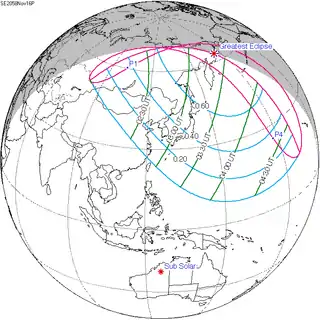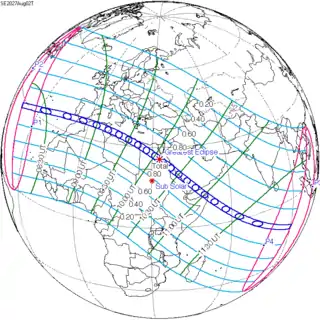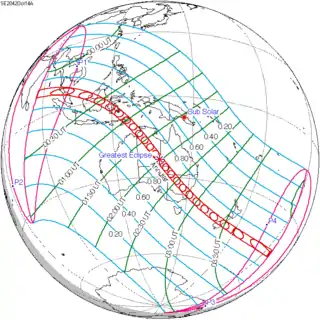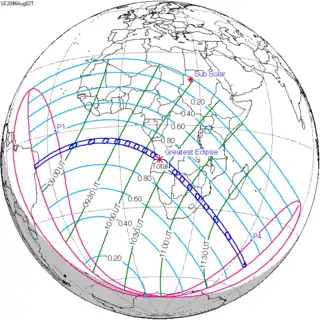| Solar eclipse of October 13, 2061 | |
|---|---|
 Map | |
| Type of eclipse | |
| Nature | Annular |
| Gamma | −0.9639 |
| Magnitude | 0.9469 |
| Maximum eclipse | |
| Duration | 221 sec (3 m 41 s) |
| Coordinates | 62°06′S 54°24′W / 62.1°S 54.4°W |
| Max. width of band | 743 km (462 mi) |
| Times (UTC) | |
| Greatest eclipse | 10:32:10 |
| References | |
| Saros | 154 (9 of 71) |
| Catalog # (SE5000) | 9645 |
An annular solar eclipse will occur on October 13, 2061. A solar eclipse occurs when the Moon passes between Earth and the Sun, thereby totally or partly obscuring the image of the Sun for a viewer on Earth. An annular solar eclipse occurs when the Moon's apparent diameter is smaller than the Sun's, blocking most of the Sun's light and causing the Sun to look like an annulus (ring). An annular eclipse appears as a partial eclipse over a region of the Earth thousands of kilometres wide.
Related eclipses
Solar eclipses 2059–2061
This eclipse is a member of a semester series. An eclipse in a semester series of solar eclipses repeats approximately every 177 days and 4 hours (a semester) at alternating nodes of the Moon's orbit.[1]
| Solar eclipses 2059–2061 | |||||
|---|---|---|---|---|---|
| 119 | May 22, 2058 Partial |
124 | November 16, 2058 Partial | ||
| 129 | May 11, 2059 Total |
134 | November 5, 2059 Annular | ||
| 139 | April 30, 2060 Total |
144 | October 24, 2060 Annular | ||
| 149 | April 20, 2061 Total |
154 | October 13, 2061 Annular | ||
Metonic series
The metonic series repeats eclipses every 19 years (6939.69 days), lasting about 5 cycles. Eclipses occur in nearly the same calendar date. In addition, the octon subseries repeats 1/5 of that or every 3.8 years (1387.94 days). All eclipses in this table occur at the Moon's descending node.[2]
| Octon series with 21 events between May 21, 1993 and August 2, 2065 | ||||
|---|---|---|---|---|
| May 20–21 | March 8–9 | December 25–26 | October 13–14 | August 1–2 |
| 98 | 100 | 102 | 104 | 106 |
| May 21, 1955 | March 9, 1959 | December 26, 1962 | October 14, 1966 | August 2, 1970 |
| 108 | 110 | 112 | 114 | 116 |
| May 21, 1974 | March 9, 1978 | December 26, 1981 | October 14, 1985 | August 1, 1989 |
| 118 | 120 | 122 | 124 | 126 |
 May 21, 1993 |
 March 9, 1997 |
 December 25, 2000 |
 October 14, 2004 |
 August 1, 2008 |
| 128 | 130 | 132 | 134 | 136 |
 May 20, 2012 |
 March 9, 2016 |
 December 26, 2019 |
 October 14, 2023 |
 August 2, 2027 |
| 138 | 140 | 142 | 144 | 146 |
 May 21, 2031 |
 March 9, 2035 |
 December 26, 2038 |
 October 14, 2042 |
 August 2, 2046 |
| 148 | 150 | 152 | 154 | 156 |
 May 20, 2050 |
 March 9, 2054 |
 December 26, 2057 |
 October 13, 2061 |
 August 2, 2065 |
| 158 | 160 | 162 | 164 | 166 |
 May 20, 2069 |
March 8, 2073 | December 26, 2076 | October 13, 2080 | August 1, 2084 |
References
- ↑ van Gent, R.H. "Solar- and Lunar-Eclipse Predictions from Antiquity to the Present". A Catalogue of Eclipse Cycles. Utrecht University. Retrieved 6 October 2018.
- ↑ Note S1: Eclipses & Predictions in Freeth, Tony (2014). "Eclipse Prediction on the Ancient Greek Astronomical Calculating Machine Known as the Antikythera Mechanism". PLOS ONE. 9 (7): e103275. Bibcode:2014PLoSO...9j3275F. doi:10.1371/journal.pone.0103275. PMC 4116162. PMID 25075747.
.jpg.webp)

